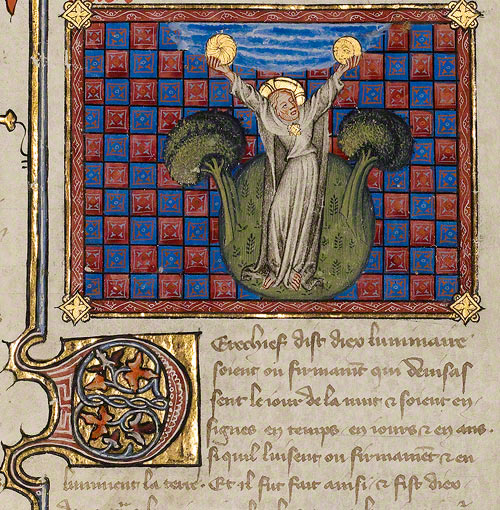
The Creation of the Sun and the Moon (detail), Master of Jean de Mandeville, in Historical Bible (Bible historiale; original sources in Latin), Paris, about 1360–70. The J. Paul Getty Museum. Ms. 1, vol. 1, fol. 5
This post was written in conjunction with the exhibition “Imagining the Past in France, 1250–1500” in 2011. But it still serves as a great FAQ about the captivating art of illuminated manuscripts. —Ed.
Every day at 1:30 p.m., I and other gallery teachers give tours of the exhibition Imagining the Past in France, 1250–1500—closing Sunday—which features illuminated manuscripts of kings and battles, myths and legends, Biblical heroes and parables, and other tales intended to bring the past alive before the eyes of medieval French readers.
I like to start off my tours with a question that gets the conversation flowing: How do you define “history”? The most frequent responses have been: “History is…a record of past events…important wars…stories written by the victorious…” It’s remarkable to find out how ideas about the past have changed—or not—since the Middle Ages.
Your questions are essential to our work, because they guide us to seek out and share the information that you want to know about works of art. We’ve been getting lots of questions about the deluxe French historical manuscripts in the exhibition, so we’ve been keeping track of them. Here, the answers to some of the most interesting.
Audrey Chan: Painted books are referred to as “illuminated” manuscripts. What exactly does “illuminated” mean?
Elizabeth Morrison: The word illumination comes from the Latin verb illuminare (to light up), which, in this context, describes the glow created by the radiant colors of the painted illustrations and the use of gold paint and gold leaf. Illumination took the form of decorated letters, borders, and independent painted scenes, called miniatures. It was Italian poet Dante Alighieri (1265–1321) who coined the term “illumination” in Purgatorio, Canto XI:
“O,” asked I him, “art thou not Oderisi,
Agobbio’s honour, and honour of that art
Which is in Paris called illuminating?”
How long did it take to make an illuminated manuscript?
It varied depending on page size, number of pages, and quantity and quality of illustrations—but a single manuscript could take several years to complete. Here’s one example. The Mirror of History, two volumes of which are on loan from the University Library in Leiden and Bibliothèque de l’Arsenal in Paris, was originally composed of four volumes containing 1,000,000 handwritten words and 1,600 illuminations. In another, it took three artists two years to complete just 384 of the planned 5,112 images. At that rate, it would have taken them almost 20 years to complete the entire manuscript!

Parchment being stretched on a wooden frame to create a smooth sheet for a manuscript.
The parchment used to make manuscripts was made from animal skins—so did it smell? And what about the egg in tempera paint; did it smell bad or rot?
The first stages of parchment preparation certainly smelled! The animal hide was soaked in lime for weeks before the excess flesh and hair were removed. Then it was stretched on a frame so that the fibers within the skin would lie almost parallel to form a smooth sheet. Parchment can last a very long time if protected from humidity, but it does not smell.
To make egg tempera paint, egg is mixed with water and pigment, which somewhat neutralizes the decomposition process of eggs, but it is also spread so thinly and dries so quickly that it never really has the chance to rot. Therefore it doesn’t smell.
How do we know which artists painted which illuminations?
Part of the job of art historians, such as exhibition curators Elizabeth Morrison and Anne D. Hedeman, is to “train” their eyes to recognize the same style from one manuscript to another. Rarely do they have documentation that assigns a particular manuscript to a particular artist, but if they do, they can then assign other manuscripts to the same artist by comparing stylistic features.
Many times, art historians have no name to associate with a particular artist, but they still want to say that, based on style, this manuscript in Paris and that manuscript in Los Angeles must be by the same person—so the artist is given a name of convenience, like Boucicaut Master (named for a famous manuscript made for the Maréchal de Boucicaut) or the Master of the Dark Eyes (you might imagine why he got that name).
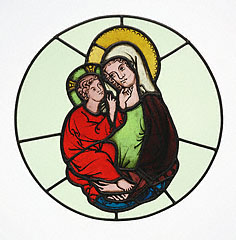
The Virgin and Child, Master of Klosterneuburg, about 1335. Pot-metal and clear glass with vitreous paint and silver stain, 14 1/8 in. high. The J. Paul Getty Museum, 2003.32
Which came first, manuscripts or stained glass? Did these forms influence each other?
Illuminated manuscripts were produced during a period of roughly a thousand years, between the 6th and 16th centuries, across Europe and also in the Middle East and Africa. Stained glass developed in parallel to manuscript illumination as a sacred art form, but it truly began to flourish as a pictorial medium during the 10th century.
Stained glass panels in churches and cathedrals often illustrated stories from the Bible for a largely illiterate populace. Manuscript illumination and stained glass mutually influenced each other, and would also come to influence other art forms such as tapestries, decorative objects, and even playing cards.
How have medieval manuscripts been preserved all this time?
Manuscripts contain some of the most well-preserved examples of medieval painting because they were designed with built-in protection in the form of rigid bindings, often made of leather. When closed, manuscripts were protected from environmental damage from light, dust, and humidity. Books were also more portable and easier to store than paintings and larger site-specific artworks, such as altarpieces.
Were there medieval books that contained only text, and no images?
During the 13th century, French monarchs promoted the translation of texts from Latin into vernacular French, leading Paris to become the cultural center of 13th-century Europe and the heart of a flourishing commercial book trade. While the exhibition Imagining the Past in France features the deluxe volumes produced for the medieval French court, less expensive—but still luxurious—manuscripts were also produced for well-to-do Parisians and university scholars.
Even when these books contained only text, they would still feature decorated initials and marginalia, often embellished with gold leaf. However, the majority of books that survive from the Middle Ages contain only text with no decoration at all, as they were made solely to be read rather than as luxury objects.
I see one manuscript in the exhibition that has a completely blank page. Why?
The Trial of the Duke of Alençon, a full-page illustration from Giovanni Boccaccio’s Concerning the Fates of Illustrious Noble Men and Women, depicts the trial of a trusted member of the French court who notoriously committed treason by conspiring with the English during the Hundred Years’ War.
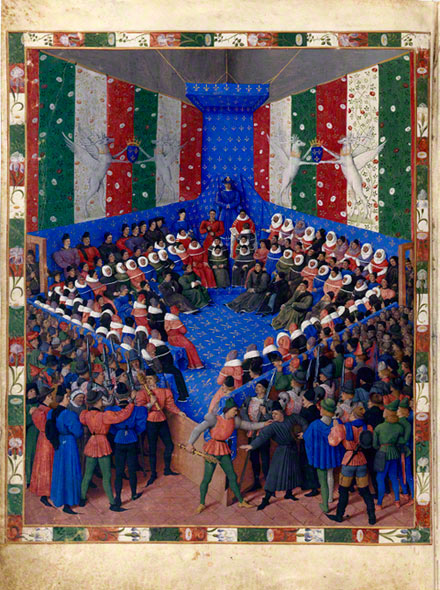
The Trial of the Duke of Alençon, Jean Fouquet, about 1459-60. In Concerning the Fates of Illustrious Men and Women (Des cas des nobles hommes et femmes; original text in Latin); Giovanni Boccaccio, author; Laurent de Premierfait, translator. Bayerische Staatsbibliothek, Munich. Ms. Cod. Gall. 6, fol. 2v
There is no text on the facing page because the trial took place about 75 years after the death of the text’s author, Boccaccio. The image was added as a contemporary example of the fate that awaits those guilty of the sins of pride and greed. In fact, the trial was still so fresh in contemporary viewers’ minds that the image spoke for itself and needed no explanatory text.
How accurate is the history contained in these books?
History in the Middle Ages wasn’t what we consider history today: it included myth, legend, and even outright invention. The histories in this exhibition, therefore, often combine tales of true figures—such as Julius Caesar, Alexander the Great, and Charlemagne—with those of legendary figures such as King Arthur.
It also includes stories such as Alexander the Great exploring the bottom of the ocean and finding people with their dogs, or Queen Dido constructing a medieval castle on the site of ancient Carthage, or even Richard the Lionheart participating in the First Crusade (he actually took part in the Third Crusade). History in the Middle Ages was intended to entertain as well as instruct, as its primary role was not to get at the truth, but to serve as a moral and practical exemplar.
When you first enter the exhibition, you see a 34-foot-long scroll, the Universal Chronicle, that tells the history of the world. Why is England given the same amount of space as France in this chronicle?
The Universal Chronicle was made around the 1470s, about 20 years after the end of the Hundred Years’ War. Prompted by the end of the Capetian line of French kings, it was an ongoing series of battles waged between the House of Valois and the House of Plantagenet (or House of Anjou) over who was the legitimate ruler of France. (The House of Valois was ultimately victorious.)
Part of the confusion lay in the fact that there was frequent intermarriage among the French and English royal bloodlines, as kingdoms sought to expand the reach of their dominions. In the Universal Chronicle, although the histories of France and England are each given their own columns, the French kings are shown majestically in churches, their rule divined by God, whereas the English kings are shown embroiled in battle, committing fratricide, and other treachery. After all, history is written by the victor!

Middle French text in Tristan’s Stepmother Lamenting Her Dead Son (detail), unknown illuminator, in The Romance of Tristan of Léonois (Le roman de Tristan de Léonois), Paris, about 1320–40. The J. Paul Getty Museum, Ms. Ludwig XV 5, fol. 37
Were the manuscripts written in Picard or Norman French?
The manuscripts in the exhibition feature a number of different dialects of French. Although most of the manuscripts feature the French spoken in Paris, there are also manuscripts in Provencal, Anglo-Norman, and Picard. In addition, the French language, even in the region around Paris, changed dramatically in the period covered in the exhibition, so that the earliest manuscripts from around 1250 are in Old French, while those from around 1500 are in Middle French.
Have any of these manuscripts been translated into English?
Some of the texts featured in the exhibition have never been edited; others have been translated into modern French; and still others have been translated into English. Probably less than 10 percent of the texts represented in the exhibition have been translated into English.
Will these books be digitized so we can flip through them online?
Many of the books borrowed for the exhibition have been digitized by the lending institutions and made available on their websites. The National Library of France, the National Library of the Netherlands at The Hague, and the British Library, to give just a few examples, all feature many of their treasures online. Probably about half of the manuscripts featured in the exhibition have been digitized and are available on the web. As the borrower, we don’t have permission to do any digitization ourselves.
Special thanks to curator Elizabeth Morrison and gallery teachers Nancy Real and Lilit Sadoyan for their invaluable research and contributions to this post.

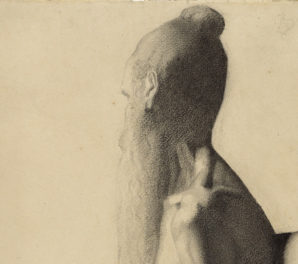
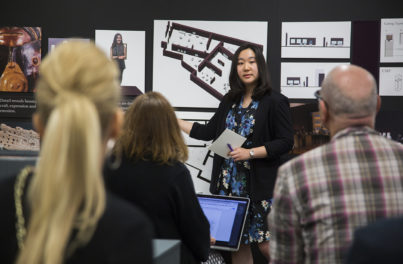
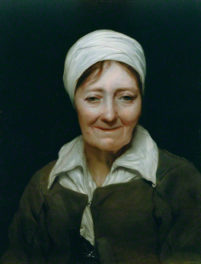
This essay is illuminating to me. — a favorite visitor
Hi there. I own two ancient French parchments – one dated 1472 and the other dated 1524.
I wish to have these translated and was wondering whether, in this wonderful Internet world, whether there is an App whereby one could scan the written words and have these translated into English? Otherwise, could you advise any other method to have this work done?
These are wonderful works and it would be so great to finally unlock the written words. With regards, Dr Nigel Vincent.